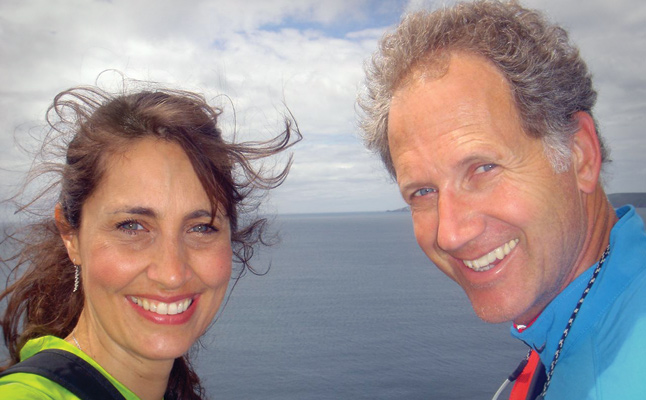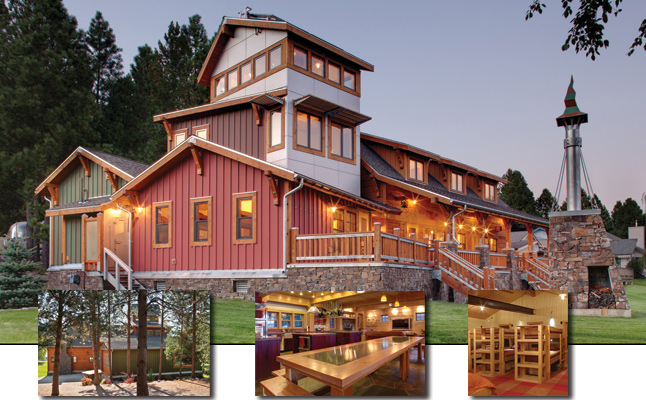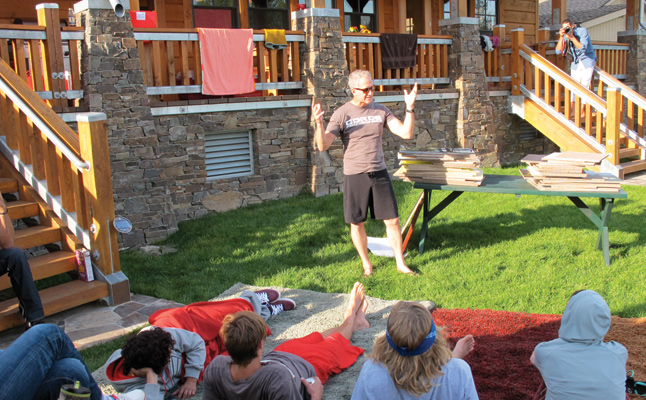
Nike VP Tinker Hatfield designed Camp Hatfield at Oden Bay as a gift for his wife, Jackie, who always dreamed of being a camp director. COURTESY PHOTO
Tinker Hatfield
Nike vice president of design and Air Jordan architect
Story By ERIC PLUMMER
Photos by Marie-Dominique Verdier
Tinker Hatfield can't travel anywhere in the world without seeing something that he has designed. As the vice president of design and special projects at a little company called Nike, Hatfield is most famous for designing nearly every incarnation of Air Jordan basketball shoes. Along with sports icon Michael Jordan, Hatfield was largely instrumental in starting not just a shoe revolution, but a fashion movement, creating the first must-have athletic shoes and helping Nike launch an empire.
Hatfield, 58, grew up in Halsey, Oregon, where he was a three-sport standout before earning a track scholarship to the University of Oregon in 1970. He set the school's pole vault record and finished sixth in the 1976 U.S. Olympic trials.
Hatfield's track coach at Oregon was the legendary Bill Bowerman, who along with Phil Knight was a co-founder of Nike. In 1981, Hatfield went to work as the corporate architect of Nike, designing office spaces, showrooms and stores, among other things.
In 1985 he designed the original Air Max running shoe, then the first Nike cross training shoe, eventually working with a host of famous athletes. This year he has worked with the likes of Dwyane Wade and Roger Federer.
A few years ago Hatfield and his wife, Jackie, whom he met as a student at Oregon and raised three daughters with, were vacationing at a friend's place at Oden Bay in Sandpoint when the vacant lot next door went up for sale.
Hatfield quickly fell in love with the property and promptly put his architectural skills back to work designing a dream camp for Jackie. He teamed with local builder Bob Bianco to construct a one-of-a-kind, 3,300-square-foot home, using local products, environmentally friendly technology and a wealth of natural creativity.
"He truly is a design genius," said Bianco, adding that virtually everything about the building is non-standard. "His creative juices are beyond anything I've ever worked with in 30-plus years."
The camp was Tinker's gift to Jackie, fulfilling her lifelong dream to run a camp.
 In a serene lakefront setting, Camp Hatfield features a mess-hall style kitchen and bedrooms stocked with bunk beds designed for hosting groups In a serene lakefront setting, Camp Hatfield features a mess-hall style kitchen and bedrooms stocked with bunk beds designed for hosting groups
"If you've ever had that experience of going away to camp as a child — what we do at Camp Hatfield allows you to recapture that," said Jackie, who loves the outdoors and is smitten with Sandpoint. "We find the whole area enchanting. Such an eclectic mix of people, so many things to do year-round."
Sandpoint Magazine recently asked Tinker about the camp, what it's like to rub elbows with famous people and a host of other questions.
Q: How did you come by the name Tinker?
A: It was my father's nickname that was passed along to me as the firstborn. He was born prematurely at home, and he was put in a toy box — the box happened to be a wooden box for Tinker Toys. His older brother started calling him Little Tommy Tinker Toy, and it got shortened to Tinker. I like to say that the reason my name is Tinker is that my parents were on drugs in the 1950s, but that's not really the case (laughs). It's my given name and on my driver's license, and a lot of people go "what?"
Q: What led you to build Camp Hatfield in Sandpoint?
A: Before we ever thought of purchasing a property in Sandpoint, we would visit Tom and Barb Richardson and spend some time vacationing in Oden Bay near Sandpoint. It was a lovely place. I personally enjoy the water a lot, and Jackie is a real avid hiker and outdoor person and we just always enjoyed going up there. One morning a few years back we were literally sleeping in our Airstream trailer, and I actually heard the Realtor pounding the stake in to advertise the property that was next door. The following day Jackie and I went into Sandpoint and spoke to the Realtor and pretty much bought it that day.
We're not interested in elitism or lifestyles of the rich and famous. We like the fact that Sandpoint is a real town, with real people. Yet there is a hipness to it, a wide blend of people in one town. We found that very interesting.
Q: What was your wife Jackie's role in Camp Hatfield?
A: She's the inspiration for the whole thing, to be quite straightforward. She has really conducted her life as a mom and an outdoor enthusiast, almost like a camp counselor. The kids were always going on adventures, and she seems like she raised half the neighborhood. Our house was always full of young people. It was always her dream to do that kind of thing in a mountainous environment. When we acquired the property, it was my gift to her, so to speak, to conceive a camp of sorts, so that she could not only have a place to go and be on the lake and go for hikes and do things with her family, but also invite other friends and maybe some kids and hopefully grandkids someday and essentially have kind of her own little mini-camp.
Q: Jackie called you and Bob Bianco a "dream team." Why?
A: Living in Portland and traveling as much as I do, I knew I wasn't going to be up in Sandpoint nearly enough during the construction, and so I really was concerned about finding the right builder. Bob became not only the builder, but I would call him a design collaborator, because a lot of times you have to make decisions on the fly, make adjustments and interpret design work. As a builder he was just fantastic. Without him, the project just wouldn't have gone well. He's very creative and very attentive to all the details, and very knowledgeable about construction. I've been in the design business 40 years, and I've never worked with a better builder in my entire career.
Q: What is the most unique aspect of Camp Hatfield?
A: Certainly the tower. The tower is three things: It's a metaphor for the camp — kind of like the U.S. Forest Service has lookout towers all over where there are big mountains and forests. It also has a real functional purpose. It's a cooling tower, as well as a heating tower. It has this duality from a functional perspective where it works like a chimney flue and sucks hot air out during the summer; you don't need air conditioning because of that. It's also a heating tower. It's up high above the trees and it became a great location to place our solar hot water system.

Tinker Hatfield speaks at an eco conference with 16 Nike-sponsored athletes held last year at Camp Hatfield
Q: You had a camp last fall with 16 Nike athletes. What was the purpose of that camp and who were some of the athletes that attended?
A: Nike asked me if it would be OK to invite some athletes up there to have an eco conference with our best action sports athletes from around the world: Nicolas Mueller from Switzerland, who is one of the best snowboarders; Paul Rodriguez, probably the most famous street skateboarder. Nike wanted to bring them all into a unique, sort of non-commercial outdoor world, and then invite in a bunch of speakers, environmentalists and people who are trying to save the world. The idea being that if you could educate these highly visible, influential athletes, that you could in turn influence millions of young people to do a better job with the environment.
They just loved being in Sandpoint. The report is they're doing amazing things and spreading the word. It's a wonderful development that all basically came from Sandpoint. It's affected literally millions of young people around the planet.
Q: When you find out you're going to design an Air Jordan, what is the first thing that goes through your head?
A: I always give Michael Jordan a call and go visit with him and talk to him about what's going on in his life. It's all about being inspired by him. It used to be about how he played the game. Now, as we continue to design the shoes, they're more about other athletes that we hire for the Jordan brand. Tomorrow I'll be meeting with Dwyane Wade, who is a Jordan athlete, so sort of by proxy, or through Dwyane Wade, we look at how he plays the game and how to design the shoes that work for him.
Still, there is this overriding theme behind Jordans, which is to design a really high quality, high performing, sophisticated basketball product that is befitting of Michael himself. I'll talk to him about his life, what cars he's driving, what he's been doing with his spare time, just getting inspired by various things around his life, and then somehow weave that into the design of the product.
Q: If you had to pick one thing, what do you love most about designing shoes?
A: For me, I don't even think of them as shoes. I'm really big on collaboration. Working with Bob Bianco was a collaboration, and working with Michael Jordan is pretty much a similar kind of collaboration, in that you have to blend your own ideas with the ideas of someone else. When I design something for Nike, it gets sold all around the world, pretty much.
I've designed so many projects that I literally can't go anywhere in the world — the Caribbean, West Africa or China — without seeing something I've designed. That's pretty heady stuff. It's less about what my design skill is and more about the power of a brand like Nike. People probably don't think of sneakers as being that important, but they've become an important part of our modern culture. We know of a few pairs of shoes that are worth $100,000 and they are Air Jordans (laughs).
Q: What are some of the other things you design other than shoes?
A: I've designed a lot of things for the University of Oregon. Most recently I designed the actual playing surface for the new Mathew Knight Arena in Eugene. The (basketball) floor needed to be unique. I'm working on a big indoor track for the University of Oregon right now. If it ever gets built, it will be about a 400,000 to 500,000 square foot building.
Q: What's the best part about working for Nike, and what's the worst part?
A: The best part is the incredible economy of scale and the power of changing the world, so to speak. I don't mean that in a grandiose way, I mean that in a good way. If you practice environmentalism by yourself, that's great. But when you practice it at Nike, it has a huge impact across a very wide spectrum of people. There is a lot of power in the scale of a company like Nike, a lot of good power.
The bad part about Nike is just politics. It's sort of like trying to work in a small country. You have to lobby for resources and fight for your ideals, make sure that your projects aren't eliminated. It's a $20 billion company with thousands of employees and a lot of decisions are made that I don't necessarily agree with.
Q: When you're not designing things, what are some of your hobbies?
A: I'm desperately trying to become a surfer, and I like to cycle and rock climb. My body is so beat up from pole vaulting and football. I need to find sports that aren't tough on the body.
|